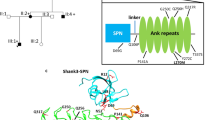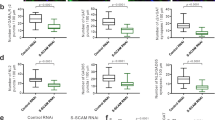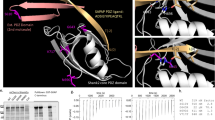Abstract
Neuroligins are postsynaptic cell-adhesion molecules that bind to presynaptic neurexins. Although the general synaptic role of neuroligins is undisputed, their specific functions at a synapse remain unclear, even controversial. Moreover, many neuroligin gene mutations were associated with autism, but the pathophysiological relevance of these mutations is often unknown, and their mechanisms of action uninvestigated. Here, we examine the synaptic effects of an autism-associated neuroligin-4 substitution (called R704C), which mutates a cytoplasmic arginine residue that is conserved in all neuroligins. We show that the R704C mutation, when introduced into neuroligin-3, enhances the interaction between neuroligin-3 and AMPA receptors, increases AMPA-receptor internalization and decreases postsynaptic AMPA-receptor levels. When introduced into neuroligin-4, conversely, the R704C mutation unexpectedly elevated AMPA-receptor-mediated synaptic responses. These results suggest a general functional link between neuroligins and AMPA receptors, indicate that both neuroligin-3 and -4 act at excitatory synapses but perform surprisingly distinct functions, and demonstrate that the R704C mutation significantly impairs the normal function of neuroligin-4, thereby validating its pathogenicity.
This is a preview of subscription content, access via your institution
Access options
Subscribe to this journal
Receive 12 print issues and online access
$259.00 per year
only $21.58 per issue
Buy this article
- Purchase on Springer Link
- Instant access to full article PDF
Prices may be subject to local taxes which are calculated during checkout





Similar content being viewed by others
References
Sudhof TC . Neuroligins and neurexins link synaptic function to cognitive disease. Nature 2008; 455: 903–911.
Ichtchenko K, Hata Y, Nguyen T, Ullrich B, Missler M, Moomaw C, Südhof TC . Neuroligin 1: a splice site-specific ligand for beta-neurexins. Cell 1995; 81: 435–443.
Ichtchenko K, Nguyen T, Sudhof TC . Structures, alternative splicing, and neurexin binding of multiple neuroligins. J Biol Chem 1996; 271: 2676–2682.
Bolliger MF, Pei J, Maxeiner S, Boucard AA, Grishin NV, Südhof TC . Unusually rapid evolution of Neuroligin-4 in mice. Proc Natl Acad Sci USA 2008; 105: 6421–6426.
Song JY, Ichtchenko K, Sudhof TC, Brose N . Neuroligin 1 is a postsynaptic cell-adhesion molecule of excitatory synapses. Proc Natl Acad Sci USA 1999; 96: 1100–1105.
Varoqueaux F, Jamain S, Brose N . Neuroligin 2 is exclusively localized to inhibitory synapses. Eur J Cell Biol 2004; 83: 449–456.
Hoon M, Soykan T, Falkenburger B, Hammer M, Patrizi A, Schmidt KF, et al. Neuroligin-4 is localized to glycinergic postsynapses and regulates inhibition in the retina. Proc Natl Acad Sci USA 2011; 108: 3053–3058.
Takacs VT, Freund TF, Nyiri G . Neuroligin 2 is expressed in synapses established by cholinergic cells in the mouse brain. PLoS One 2013; 8: e72450.
Budreck EC, Scheiffele P . Neuroligin-3 is a neuronal adhesion protein at GABAergic and glutamatergic synapses. Eur J Neurosci 2007; 26: 1738–1748.
Zhang C, Milunsky JM, Newton S, Ko J, Zhao G, Maher TA, et al. A neuroligin-4 missense mutation associated with autism impairs neuroligin-4 folding and endoplasmic reticulum export. J Neurosci 2009; 29: 10843–10854.
Jamain S, Quach H, Betancur C, Råstam M, Colineaux C, Gillberg IC, et al. Mutations of the X-linked genes encoding neuroligins NLGN3 and NLGN4 are associated with autism. Nat Genet 2003; 34: 27–29.
Laumonnier F, Bonnet-Brilhault F, Gomot M, Blanc R, David A, Moizard MP, et al. X-linked mental retardation and autism are associated with a mutation in the NLGN4 gene, a member of the neuroligin family. Am J Hum Genet 2004; 74: 552–557.
Lawson-Yuen A, Saldivar JS, Sommer S, Picker J . Familial deletion within NLGN4 associated with autism and Tourette syndrome. Eur J Hum Genet 2008; 16: 614–618.
Talebizadeh Z, Lam DY, Theodoro MF, Bittel DC, Lushington GH, Butler MG . Novel splice isoforms for NLGN3 and NLGN4 with possible implications in autism. J Med Genet 2006; 43: e21.
Xu X, Xiong Z, Zhang L, Liu Y, Lu L, Peng Y, et al. Variations analysis of NLGN3 and NLGN4X gene in Chinese autism patients. Mol Biol Rep 2014; 41: 4133–4140.
Yan J, Oliveira G, Coutinho A, Yang C, Feng J, Katz C, et al. Analysis of the neuroligin 3 and 4 genes in autism and other neuropsychiatric patients. Mol Psychiatry 2005; 10: 329–332.
Etherton MR, Tabuchi K, Sharma M, Ko J, Sudhof TC . An autism-associated point mutation in the neuroligin cytoplasmic tail selectively impairs AMPA receptor-mediated synaptic transmission in hippocampus. EMBO J 2011; 30: 2908–2919.
Cao P, Maximov A, Sudhof TC . Activity-dependent IGF-1 exocytosis is controlled by the Ca(2+)-sensor synaptotagmin-10. Cell 2011; 145: 300–311.
Maximov A, Pang ZP, Tervo DG, Sudhof TC . Monitoring synaptic transmission in primary neuronal cultures using local extracellular stimulation. J Neurosci Methods 2007; 161: 75–87.
Ho A, Morishita W, Atasoy D, Liu X, Tabuchi K, Hammer RE, et al. Genetic analysis of Mint/X11 proteins: essential presynaptic functions of a neuronal adaptor protein family. J Neurosci 2006; 26: 13089–13101.
Kaeser PS, Deng L, Chávez AE, Liu X, Castillo PE, Südhof TC, et al. ELKS2alpha/CAST deletion selectively increases neurotransmitter release at inhibitory synapses. Neuron 2009; 64: 227–239.
Anderson GR, Galfin T, Xu W, Aoto J, Malenka RC, Südhof TC, et al. Candidate autism gene screen identifies critical role for cell-adhesion molecule CASPR2 in dendritic arborization and spine development. Proc Natl Acad Sci USA 2012; 109: 18120–18125.
Chanda S, Marro S, Wernig M, Sudhof TC . Neurons generated by direct conversion of fibroblasts reproduce synaptic phenotype caused by autism-associated neuroligin-3 mutation. Proc Natl Acad Sci USA 2013; 110: 16622–16627.
Aoto J, Martinelli DC, Malenka RC, Tabuchi K, Sudhof TC . Presynaptic neurexin-3 alternative splicing trans-synaptically controls postsynaptic AMPA receptor trafficking. Cell 2013; 154: 75–88.
Uemura T, Mishina M . The amino-terminal domain of glutamate receptor delta2 triggers presynaptic differentiation. Biochem Biophys Res Commun 2008; 377: 1315–1319.
Uemura T, Lee SJ, Yasumura M, Takeuchi T, Yoshida T, Ra M, et al. Trans-synaptic interaction of GluRdelta2 and neurexin through Cbln1 mediates synapse formation in the cerebellum. Cell 2010; 141: 1068–1079.
Tabuchi K, Blundell J, Etherton MR, Hammer RE, Liu X, Powell CM, et al. A neuroligin-3 mutation implicated in autism increases inhibitory synaptic transmission in mice. Science 2007; 318: 71–76.
Etherton M, Földy C, Sharma M, Tabuchi K, Liu X, Shamloo M, et al. Autism-linked neuroligin-3 R451C mutation differentially alters hippocampal and cortical synaptic function. Proc Natl Acad Sci USA 2011; 108: 13764–13769.
Rothwell PE, Fuccillo MV, Maxeiner S, Hayton SJ, Gokce O, Lim BK, et al. Autism-associated neuroligin-3 mutations commonly impair striatal circuits to boost repetitive behaviors. Cell 2014; 158: 198–212.
Irie M, Hata Y, Takeuchi M, Ichtchenko K, Toyoda A, Hirao K, et al. Binding of neuroligins to PSD-95. Science 1997; 277: 1511–1515.
Acknowledgements
We thank Jeesun Kim, Bing Wu and Yoon Seok Kim for their help during the project. This paper was supported by grants from the NIH (R37-MH052804 to TCS; MH092931 to MW), an NIH K99 award (MH103531-01 to JA) and a postdoctoral grant award (Stanford, ChEM-H112878 to SC). MW is a New York Stem Cell Foundation-Robertson Investigator and a Tashia and John Morgridge Faculty Scholar.
Author information
Authors and Affiliations
Corresponding author
Ethics declarations
Competing interests
The authors declare no conflict of interest.
Additional information
Supplementary Information accompanies the paper on the Molecular Psychiatry website
Supplementary information
Rights and permissions
About this article
Cite this article
Chanda, S., Aoto, J., Lee, SJ. et al. Pathogenic mechanism of an autism-associated neuroligin mutation involves altered AMPA-receptor trafficking. Mol Psychiatry 21, 169–177 (2016). https://doi.org/10.1038/mp.2015.20
Received:
Revised:
Accepted:
Published:
Issue Date:
DOI: https://doi.org/10.1038/mp.2015.20
This article is cited by
-
Neuroligin-3 Regulates Excitatory Synaptic Transmission and EPSP-Spike Coupling in the Dentate Gyrus In Vivo
Molecular Neurobiology (2022)
-
Open syntaxin overcomes exocytosis defects of diverse mutants in C. elegans
Nature Communications (2020)
-
Autism spectrum disorders: autistic phenotypes and complicated mechanisms
World Journal of Pediatrics (2019)
-
Neuroligin 1, 2, and 3 Regulation at the Synapse: FMRP-Dependent Translation and Activity-Induced Proteolytic Cleavage
Molecular Neurobiology (2019)
-
Gephyrin: a key regulatory protein of inhibitory synapses and beyond
Histochemistry and Cell Biology (2018)



